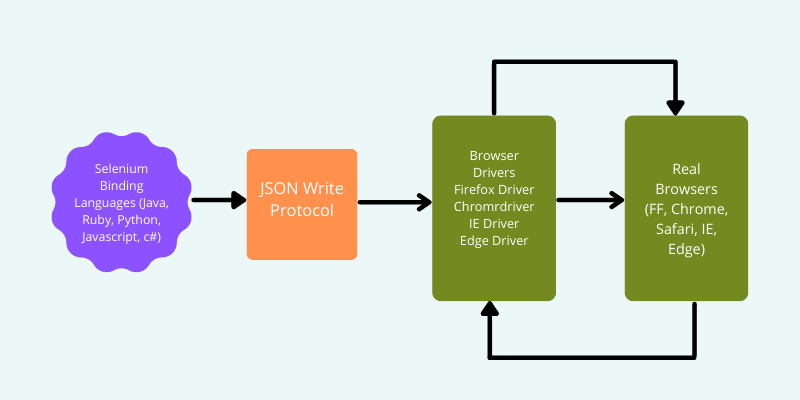Selenium is an open source framework for web application automation. Apart from that, it may perform a variety of administrative functions, such as website monitoring. In this blog, we will discuss about how does selenium work? To learn more about Selenium Testing, join FITA Academy for the best Selenium Training in Chennai.
Selenium comes in four different tastes.
- Selenium-IDE.
- Selenium-RC.
- Selenium Grid
- Selenium Web Driver
Let’s have a look at what each of them is good for.
Selenium IDE- Selenium IDE is an Integrated Development Environment (IDE) with a user-friendly interface for creating and running Selenium Test Cases. It’s a prototyping tool for creating test scripts in which the user actions are recorded as they happen. The actions are captured and saved as a script that can be used again and again. Join Selenium Training Online to learn more about Selenium Webdriver.
Although Selenium IDE is a Firefox add-on, Selenium RC allows scripts written on it to be launched on any browser.
It can be used to generate simple test cases that employ assertions and verification for the selected places, however we prefer to use Selenium RC or Web Driver for more advanced test cases.
Selenium RC- Selenium RC is a Remote Control that operates by intercepting the browser’s remote and then inserting the automation code to be tested using custom scripts. Selenium RC uses the Selenium RC Server to interface with browsers. When a web page is loaded, it injects JavaScript functions into browsers.
The RC had an advantage because it provided an automatic HTML file of test results to the user, but the Web Driver did not have this functionality.
Selenium RC includes an API and library for each of the supported languages, including Java, Ruby, C#, PHP, Perl, and Python, making it the first automated web testing tool to allow users to develop in their own language.
Selenium Grid – We use Selenium Grid to run several test cases in different remote machines at the same time. This improves the execution speed. Consider the following scenario: we have a test suite with both complex and easy test cases. We can break the test cases into groups based on their complexity and execute them independently in this scenario.
Selenium Web Driver – operates directly on the browser and uses the browser’s built-in features to trigger the automation test that the tester has prepared.
Web driver has another benefit: it can be used on HTMLUnit browsers (HTMLUnit browsers are headless browsers, which means they are invisible to the user, in other words, they have no GUI). Testing on HTMLUnit browsers is faster because these browsers save time loading page elements. As a result, test cases take less time to execute.
The key benefit of Selenium Grid is that it allows for faster and parallel execution of test cases. It performs many test cases in multiple environments on multiple remote machines with the help of Selenium RC. To learn benefits of Selenium grids, join Selenium Training in Coimbatore at FITA Academy for the best coaching.
Because Web Driver manages the browser at the OS level, it is faster than its predecessor, Selenium RC.
Let’s take a look at Selenium’s architecture to see how it works with multiple languages and browsers to get the same result, which is the execution of test cases.
The illustration above demonstrates how the selenium web driver works. The several modules that work together to run the Automated Test Scripts are listed below.
Selenium Libraries- Because of the limitations of different languages, developers have created selenium Client Libraries/language bindings to support several languages. For example, if we use java bindings for browser drivers, it will use java bindings.
Data Communication- JSON is used by the Selenium web driver to communicate between the server and the client (browser). The JSON Wire Protocol is a REST API for sending data across HTTP servers. Each Browser Driver has its own HTTP server to handle requests.
Custom Clients (Headless Browser)– Browser Drivers (Headless Browser) Custom Clients (Headless Browser) Browser Drivers work as a browser’s assistance, communicating with the browser without revealing the internal logic of the browser’s capabilities. When a browser Driver receives a command, it executes it on that browser and returns the HTTP Response. Drivers are unique to each browser that is used to establish a secure connection. All of these browser drivers run directly on top of the operating system, making them far quicker than Selenium RC.
Now that we’ve seen what happens inside the selenium, let’s take a look at the typical case-by-case execution of steps when we run a selenium script.
- For each selenium command, Selenium Script generates an HTTP Request and sends it to the browser driver.
- Browser Driver then sends an HTTP request to the server.
- On the HTTP server, the procedures are carried out.
- The execution status is provided to the HTTP server, which the automation script then captures.
Conclusion
When it comes to automation testing, Selenium is usually a topic of discussion. Selenium is well-liked by developers and testers all over the world as one of the greatest technologies for automated testing. Here, we discussed how selenium webdriver works? Join FITA Academy for the best Selenium courses.
 India Unimagined! News, Travel, Finance, Blog & Government Schemes
India Unimagined! News, Travel, Finance, Blog & Government Schemes



